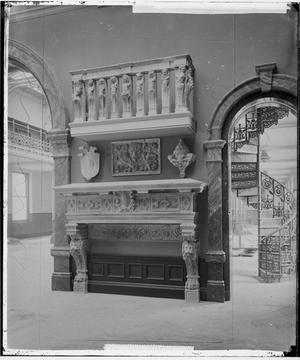News Story
(Re)opening Birmingham Museum and Art Gallery
Following Birmingham Museum & Art Gallery’s recent reopening, let’s take a closer look at the process of its very first opening 139 years ago.
Construction of Birmingham Museum and Art Gallery (BMAG) began in 1881. In 1884, seeing that the building was well under way, the Museum Committee appointed Whitworth Wallis (1855-1927) as BMAG’s first director. Wallis was born in Handsworth, Birmingham, while his father George Wallis was Headmaster of the Birmingham School of Design. After training in Germany and France in the late 1870s, Whitworth Wallis became Curator at the South Kensington Museum in London (now known as the Victoria and Albert Museum). In January 1885, Wallis stepped into his role at BMAG. His first task was to catalogue the collections (around 9,600 items, excluding paintings), which he completed in three months. Wallis also submitted his plans for the arrangement of the galleries to the Museum Committee, which approved them and purchased display cases for the objects.
Collections were arranged in the galleries throughout the summer and autumn of 1885. The first objects installed at BMAG were large architectural stone fragments (fireplaces, balconies, and doorways) dating from the 15th and 16th centuries (see figure 1). They were placed in what became the Italian Gallery, situated between the Round Room and the Industrial Gallery – which present-day visitors will know as the shop.

BMAG’s original building, adjoining the Council House, consisted of six gallery spaces. As today, the vestibule was the first gallery space greeting visitors coming up the stairs; it housed a combination of paintings, stonework, and bronzes. The Round Room was dedicated to paintings and loan collections. Collections of European and Asian decorative arts (including metalwork, ceramic, glass, textiles, and lacquer work) were displayed in the Industrial Gallery (see figure 2). As its name indicated, the Wedgwood Gallery housed contemporary and antique Wedgwood wares donated by Richard and George Tangye. The Tangye brothers were local engine manufacturers and engineers whose donations had been essential for the creation of BMAG. The final room at BMAG, following the Industrial Gallery, was another large Picture Gallery – now the tearoom.

The question of lighting, whether to use either gas or electricity, was very important in the lead up to BMAG’s opening. Artificial lights made 19th-century museums more accessible by allowing them to open until late (9 pm in the case of BMAG), which, in turn, enabled people who worked during the day to visit in the evenings. Lighting at BMAG was influenced by conservation issues, economic concerns, and a gift from a private donor. Even though artificial lights in museums were a sign of progress and innovation, they had disadvantages: exposure to gas lighting damaged fragile artworks but was cheaper than electricity. On the other hand, electricity was best for conservation and display purposes but increased the risk of fire in the galleries. In 1881, John Henry Nettlefold, a Birmingham screw manufacturer, bequeathed his collection of paintings to the city. One of the conditions for this gift was that the artworks should be exhibited by electric lighting. Eventually, the Museum Committee decided to install gas lighting throughout the galleries, with the exception of the Round Room where electricity was installed to exhibit the Nettlefold bequest.
Today, some of these gas lights, called sun-light burners, are still visible in the Industrial Gallery and have been fitted with electricity (see figure 3). In October 2024, a new illuminated feature was introduced at BMAG: the ‘Made in Birmingham’ neon sign, which shines a modern light on to the Industrial Gallery. 139 years on, BMAG sparkles brighter than ever!

by Maialen Maugars, PhD candidate in History of Art
You might also like...
 ExhibitionBirmingham Museum & Art Gallery
ExhibitionBirmingham Museum & Art GalleryModern Muse by Arpita Shah , at Birmingham Museum & Art Gallery.
Open from 24 Oct, Wed - Sun, 10am - 5pm.A series of portraits of local South Asian women by internationally-recognised artist Arpita Shah.Details ExhibitionBirmingham Museum & Art Gallery
ExhibitionBirmingham Museum & Art GalleryCurtis Holder: Drawing Carlos Acosta , at Birmingham Museum & Art Gallery.
Open from 24 Oct, Wed - Sun, 10am - 5pm.Drawings by award-winning artist Curtis Holder, featuring his portrait of Carlos Acosta, Director of Birmingham Royal Ballet.Details
